Pytorch并行训练
来源:知乎—魔法学院的Chilia
作者:https://zhuanlan.zhihu.com/p/501510475
01
只需要一行代码就可以实现DataParallel:
if torch.cuda.device_count() > 1: #判断是不是有多个GPUprint("Let's use", torch.cuda.device_count(), "GPUs!")model = nn.DataParallel(model,device_ids=range(torch.cuda.device_count()))
DataParallel方法虽然代码非常简单,但是GPU会出现负载不均衡的问题("一个gpu干活,其它gpu看戏")。第一个GPU(12GB)可能占用了10GB,剩余的GPU却只使用了2GB -- 这是极大的浪费。那么,为什么会出现这样的现象呢?我们来仔细研究一下下面这个流程图就明白了:
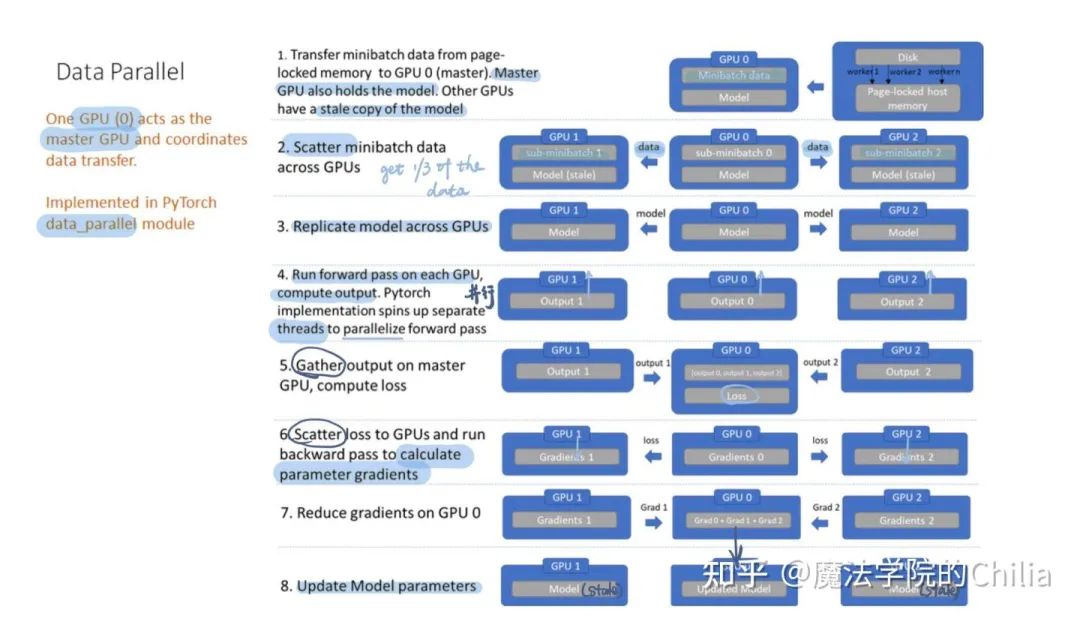
我们首先需要指定一个GPU(0)作为master GPU,它必须承担最多的负载。
第一步:GPU(0)从锁页内存(分配主机内存时锁定该页,让其不与磁盘交换。必须保证自己内存空间充足的时候才用锁页内存!)中取得一个minibatch。
第二步:GPU(0)把这个minibatch去scatter到其他GPU上,每个GPU拿到1/n的数据,这就是data parallel的定义。
第三步:GPU(0)把模型也分配到其他GPU上,现在模型是同步的
第四步:在每个GPU上并行的做forward pass,得到每个sub-minibatch的输出
第五步:GPU(0)把所有GPU的输出gather到自己这里,计算loss
第六步:GPU(0)把loss scatter到其他GPU,分别进行backward pass计算梯度
第七步:GPU(0)把梯度集中起来进行reduce,计算出梯度的总和
第八步:GPU(0)用这个梯度更新自己的模型。而其他模型没有更新,是stale版本。
我们可以看到,nn.DataParallel做了很多不必要的操作,导致其性能不佳:
第一步的时候,从page-lock memory先取数据到GPU(0),然后由GPU(0)再进行分发。为什么不能直接从page-lock memory中分发到各个GPU呢?
第五步的时候,GPU(0)拿到每个GPU的output然后计算loss,那么为什么不能每个GPU自己计算自己的loss呢?
最后一步参数的更新是在GPU(0)上进行的,此时其他GPU上的模型和GPU(0)不再同步。所以每次都需要broadcast 模型进行显式的同步。
由于loss的计算、梯度的reduce、模型的更新都是在GPU(0)上进行,所以造成了第一个GPU的负载远远大于剩余其他的GPU。
02
真正使用了多进程(process),而DataParallel只是使用了多线程(thread):
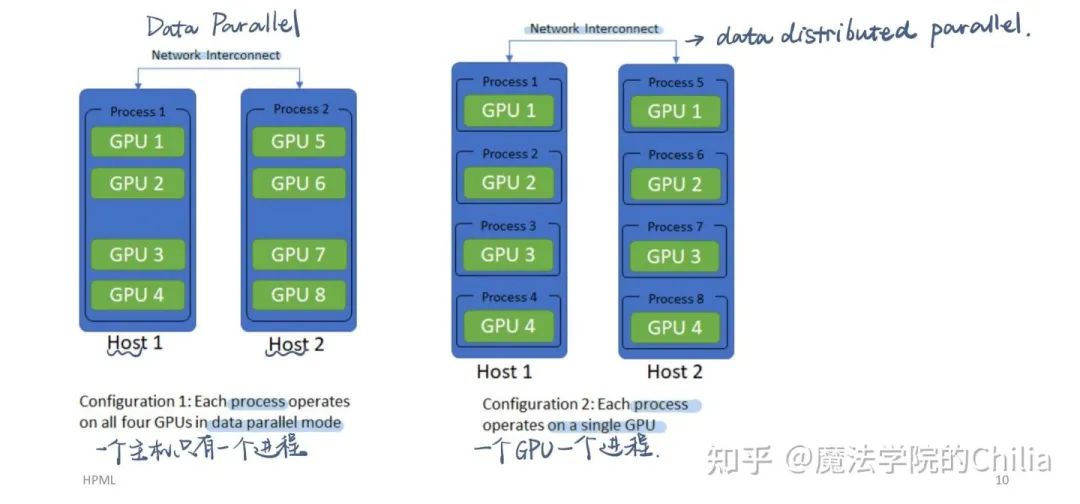
DataParallel: 一个host一个process;DistributedDataParallel: 一个GPU一个process
DistributedDataParallel是对每个GPU使用一个进程,适用于单机多卡和多机多卡的场景。它的主要工作流程如下图所示,可以看到相比DataParallel做了很多的优化:
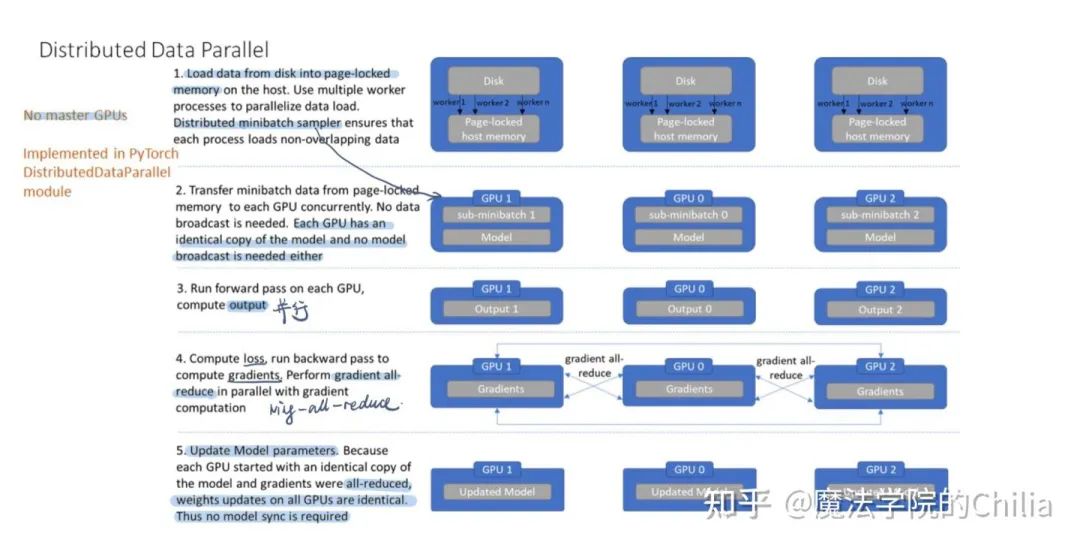
每个GPU都有一个process,分别计算在这个GPU上的loss、gradient,然后用ring-all-reduce的方式进行聚合。得到综合的gradient之后同时更新本GPU上的模型参数,所以模型一直都是同步的,不需要手动同步。
DistributedDataParallel is proven to be significantly faster than torch.nn.DataParallel for single-node multi-GPU data parallel training.
调用过程:
(1)初始化:sync the processes
#初始化使用nccl后端torch.distributed.init_process_group(backend="nccl")
Gloo(用于CPU)和NCCL(用于GPU)都是用于多个node之间通信的库。从下面的图中我们可以看到,torch.nn.parallel.DistributedDataParallel是依赖于torch.distributed的,而torch.distributed提供的是多机通信的一些原语。它依赖于Gloo/NCCL/MPI backend。
而torch.nn.DataParallel根本就是虚假的分布式!因为它只能使用于单个node,而且是单进程(single process)的,它的并行化全部依赖于线程(thread)。
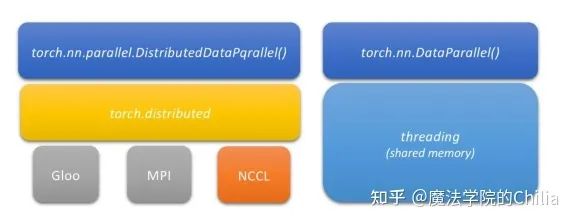
(2)使用DistributedSampler
多gpu训练是,我们希望同一时刻在每个gpu上的数据是不一样的,这样相当于batch size扩大了N倍,因此起到了加速训练的作用。DistributedSampler用于把锁页内存的一个minibatch再进行切分,分配到不同的GPU进程中去。要保证这样的划分是没有overlap的。
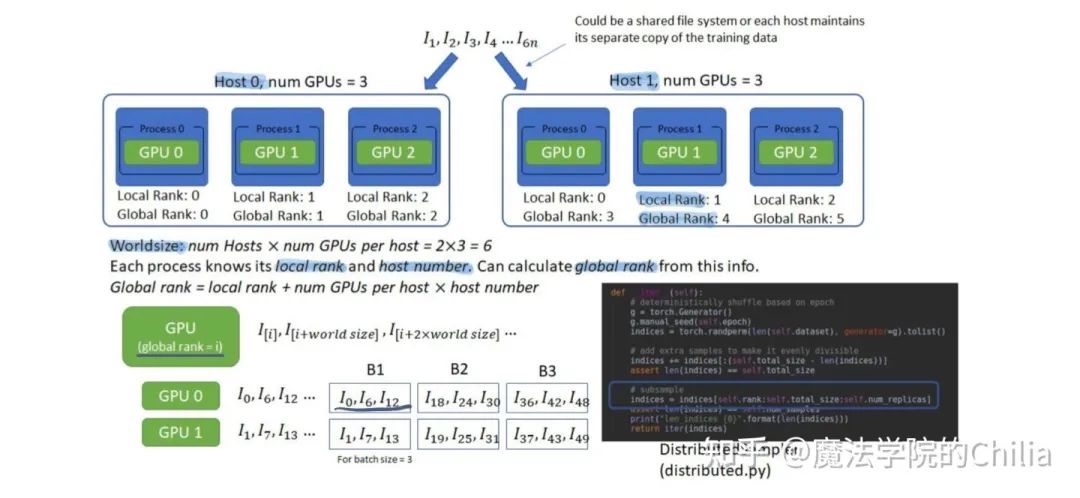
每个进程都知道自己的local rank 和 host number,就可以推算出自己的global rank, 然后获得自己应有的那一份sub-minibatch数据,保证每个进程拿到的数据没有重叠。
03
dist.broadcast(tensor,src,group): 对于group中的所有GPU编号,把tensor从src GPU分发到其他的GPU process中
dist.reduce(tensor,dst,op,group): Applies op to all tensor in group and store the result in dst.
dist.all_reduce(tensor,op,group): Same as reduce, but the result is stored in all processes.
dist.scatter(tensor,src,scatter_list,group): copy the ith tensor scatter_list[i] to the ith process.
dist.gather(tensor, dst, gather_list, group): copy tensor from all processes in group in dst
dist.all_gather(tensor_list,tensor,group): copy tensor from all processes to tensor_list, on all processes.
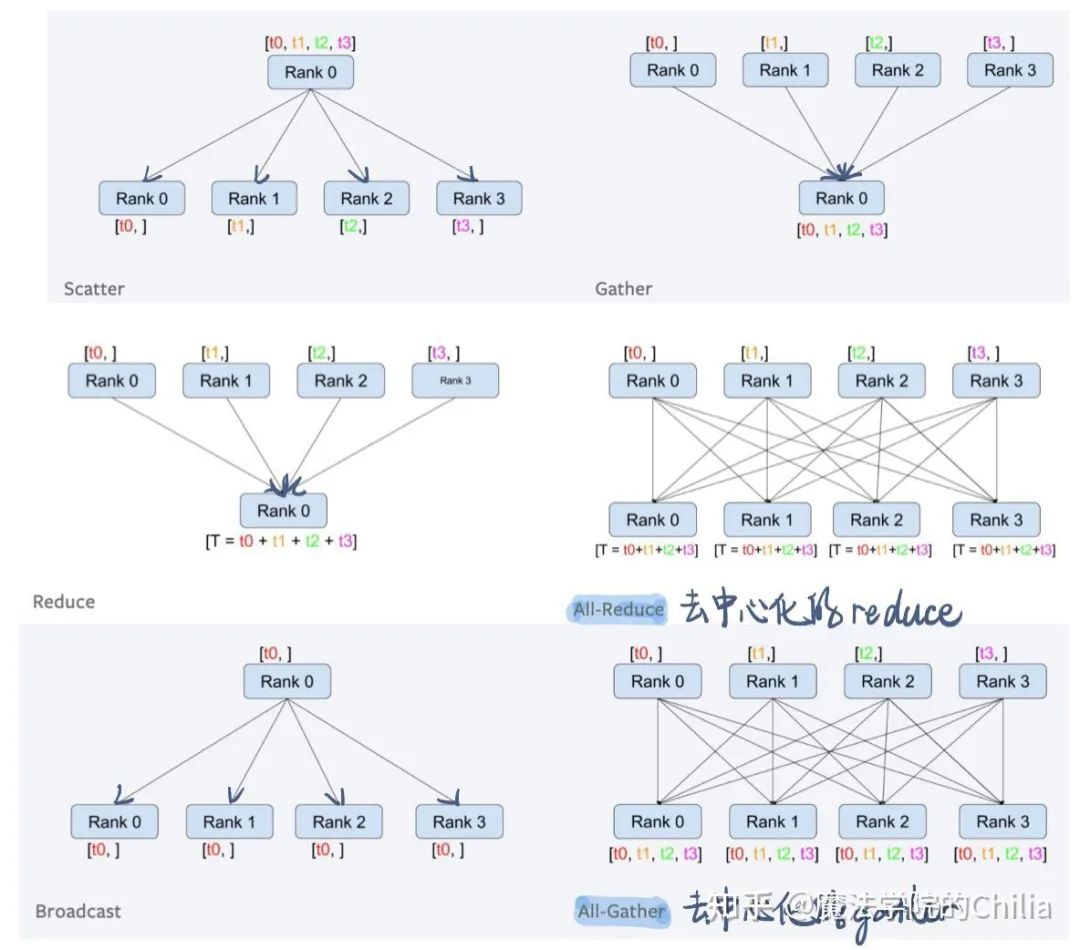
下面我们来看一个例子:
import torchimport argparsefrom torch import distributed as distprint(torch.cuda.device_count()) # 打印gpu数量torch.distributed.init_process_group(backend="nccl") # 并行训练初始化,'nccl'模式print('world_size', torch.distributed.get_world_size()) # 打印当前进程数# 下面这个参数需要加上,torch内部调用多进程时,会使用该参数,对每个gpu进程而言,其local_rank都是不同的;parser.add_argument('--local_rank', default=-1, type=int)args = parser.parse_args()torch.cuda.set_device(args.local_rank) # 设置gpu编号为local_rank;此句也可能看出local_rank的值是什么'''多卡训练加载数据:注意shuffle与sampler是冲突的,并行训练需要设置sampler,此时务必# 要把shuffle设为False。但是这里shuffle=False并不意味着数据就不会乱序了,而是乱序的方式交给# sampler来控制,实质上数据仍是乱序的。'''train_sampler = torch.utils.data.distributed.DistributedSampler(My_Dataset)dataloader = torch.utils.data.DataLoader(ds,batch_size=batch_size,shuffle=False,num_workers=16,pin_memory=True, ##锁页内存drop_last=True,sampler=self.train_sampler)'''多卡训练的模型设置:'''def average_gradients(model): ##每个gpu上的梯度求平均size = float(dist.get_world_size())for param in model.parameters:dist.all_reduce(param.grad.data,op = dist.reduce_op.SUM)param.grad.data /= sizeMy_model = My_model.cuda(args.local_rank) # 将模型拷贝到每个gpu上.直接.cuda()也行,因为多进程时每个进程的device号是不一样的My_model = torch.nn.SyncBatchNorm.convert_sync_batchnorm(My_model) # 设置多个gpu的BN同步My_model = torch.nn.parallel.DistributedDataParallel(My_model,device_ids=[args.local_rank],output_device=args.local_rank,find_unused_parameters=False,broadcast_buffers=False)'''开始多卡训练:'''for epoch in range(200):train_sampler.set_epoch(epoch) # 这句莫忘,否则相当于没有shuffle数据My_model.train()for idx, sample in enumerate(dataloader):inputs, targets = sample[0].cuda(local_rank, non_blocking=True), sample[1].cuda(local_rank, non_blocking=True)opt.zero_grad()output = My_model(inputs)loss = My_loss(output, targets)loss.backward()average_gradient(My_model) ##计算梯度的平均opt.step() ##根据梯度更新模型'''多卡测试(evaluation):'''if local_rank == 0:My_model.eval()with torch.no_grad():acc = My_eval(My_model)torch.save(My_model.module.state_dict(), model_save_path)dist.barrier() # 这一句作用是:所有进程(gpu)上的代码都执行到这,才会执行该句下面的代码'''其它代码'''
在分布式的GPU上进行SGD,每个GPU在计算完梯度之后,需要把不同GPU上的梯度进行all-reduce,即计算所有GPU上梯度的平均值:dist.all_reduce(param.grad.data, op=dist.reduce_op.SUM), 意为我们对每个模型参数的梯度进行all_reduce, 采用求和的形式计算all_reduce.
最后一步,运行上述代码的方式(8卡为例):
python3 -m torch.distributed.launch --nproc_per_node=8 DDP.py
参考资料:
熊勒个猫:和nn.DataParallel说再见
https://zhuanlan.zhihu.com/p/95700549
格子不太方:pytorch 并行训练之DistributedDataParallel(代码样例和解释)
https://zhuanlan.zhihu.com/p/350301395
Columbia University COMS 6998: Deep Learning System 课件
猜您喜欢:
 戳我,查看GAN的系列专辑~!
戳我,查看GAN的系列专辑~!附下载 |《TensorFlow 2.0 深度学习算法实战》
